Google Nexus 7 and Android 4.1 - Mini Review
by Brian Klug on June 28, 2012 3:25 AM EST- Posted in
- Tablets
- Smartphones
- Mobile
- Nexus 7
- Android 4.1
The fact that Google launched a 7" tablet by ASUS isn't a particularly huge surprise, given that ASUS showed off the Eee Pad Memo back at CES. The story goes that Google liked that particular tablet so much, it became slotted in to become the first Nexus tablet, much to Samsung's chagrin. While there have been other "Google Experience" tablets before (for example the Motorola Xoom), there hasn't been a bona-fide Nexus tablet yet, and especially not one at an aggressive price point like this. For that, enter the Nexus 7.
The Nexus 7 comes with Android 4.1 Jelly Bean installed, which we're going over on the next page. It brings improvements to UI performance through Android
Most important is the Nexus 7's price point, which up until now has largely been one of the main issues with Android tablets - price. It's fair to say that the Kindle Fire has done a good job proving that there is indeed a market for lower cost, simplified tablets at an aggressive price point, and the Nexus 7 is Google's answer. Pricing for the Nexus 7 is $199 for the 8 GB model, and $249 for the 16 GB model. There aren't any other differences between the two, nor is there a model with cellular connectivity – this is strictly WiFi only, but again, this is a tablet for the masses without the carrier hurdle.
| ASUS Tablet Specification Comparison | ||||||
| ASUS Transformer Pad Infinity | ASUS Transformer Pad 300 Series | ASUS Eee Pad Transformer Prime | ASUS Nexus 7 | |||
| Dimensions | 263 x 180.6 x 8.4mm | 263 x 180.8 x 9.9mm | 263 x 180.8 x 8.3mm | 198.5 x 120 x 10.45mm | ||
| Chassis | Aluminum + Plastic RF Strip | Plastic | Aluminum | Plastic + Rubber back | ||
| Display | 10.1-inch 1920 x 1200 Super IPS+ | 10.1-inch 1280 x 800 IPS | 10.1-inch 1280 x 800 Super IPS+ | 7" 1280 x 800 IPS | ||
| Weight | 594g | 635g | 586g | 340 g | ||
| Processor |
1.6GHz NVIDIA Tegra 3 (T33 - 4 x Cortex A9) |
NVIDIA Tegra 3 (T30L - 4 x Cortex A9) |
1.3GHz NVIDIA Tegra 3 (T30 - 4 x Cortex A9) | 1.3 GHz NVIDIA Tegra 3 (T30L - 4 x Cortex A9) | ||
| Memory | 1GB DDR3-1600 | 1GB | 1GB | 1 GB | ||
| Storage | 32/64GB + microSD slot | 16GB/32GB + microSD slot | 32GB/64GB + microSD slot | 8 GB / 16 GB | ||
| Battery | 25Whr | 22Whr | 25Whr | 16 Whr | ||
| Pricing | $499/$599 | $379/$399 | $499/$599 | $199/$249 | ||
When you look at the above specs, it seems puzzling that ASUS was able to get the price down to $199 so effectively. Getting to that lower price point is easier with a few things - physically smaller device and display, exclusion of full size USB or other ports (there's only microUSB), no rear facing camera, and good commodity component sourcing. The added plus is that if you run 1280 x 800 at a smaller size, out comes a pretty high DPI panel at the same time. Other than that though, you end up getting a device which is actually very impressive otherwise, with a quad core SoC and attractive form factor.
I like starting with physical impressions since it's the easy route, and so much of one's experience with a given device depends on that ever important in-hand feel. ASUS has taken an excellent direction here and made the back construction of the Nexus 7 a great textured rubber material. There's Nexus embossed in the top, and ASUS proudly at the bottom. Below that is a small notch for the speaker, which goes pretty loud.
The power / lock and standby buttons get placed on the top right corner, and both microUSB and the headphone jack are located at the very bottom. There are also some pogo pins on the bottom left, just like the Galaxy Nexus. No doubt these will work with some future unannounced accessories.
The Nexus 7's construction is downright impressive. While I haven't been doing regular tablet reviews (that has become Anand's domain largely), I have handled a number of recent tablets big and small, and some feel downright cheap to me thanks to the back plastic. I would not have guessed that the Nexus 7 is a $199 device based on how it feels. There's no flex or creaking at all, it feels absolutely rigid. The tradeoff is that the Nexus 7 is slightly thicker than some other devices, at almost 10.5 mm (compared to 8.5 or 9), but that larger thickness also permits a bigger edge bevel radius. I feel that 7" is an ideal tablet form factor for me personally.
So the next logical question is what performance is like on the Nexus 7. I asked around, did my own digging, and wound up confirming that what's inside the Nexus 7 is indeed a Tegra T30L SoC. This is a lower leakage / lower binning T30 that no doubt is offered at a cost advantage to ASUS - I was expecting a T30L inside and am wholly unsurprised to see one. The only difference is that CPU clocks are 1.15 GHz for all four cores at 100%, or 1.3 GHz on a single core. The GPU clock is also slightly lower at 416 MHz. The Nexus 7 also ships with 1 GB of RAM, and I'm pretty certain this is DDR2 at 500 MHz based on what I see from the digging I've done.
I've borrowed Anand's TF700T review graphs and added data from the Nexus 7 that I hastily ran this afternoon. The results are in line with my expectations for T30L and other devices with T30L inside that we've already benchmarked.
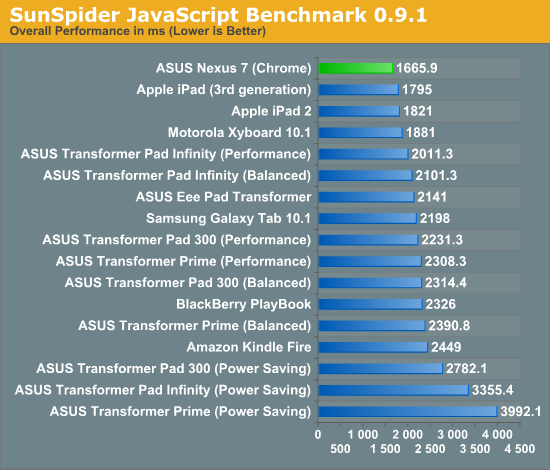
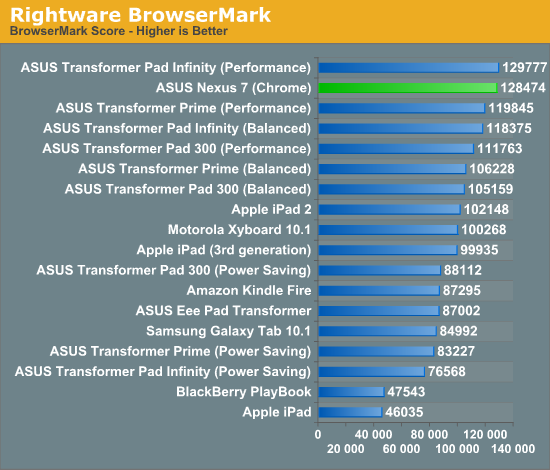
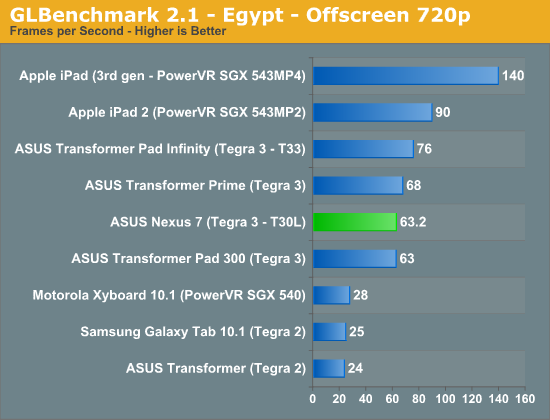
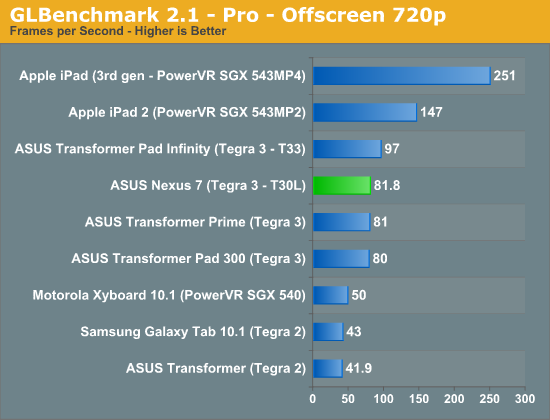
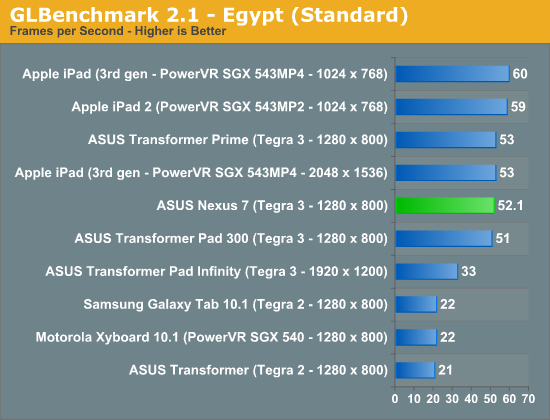
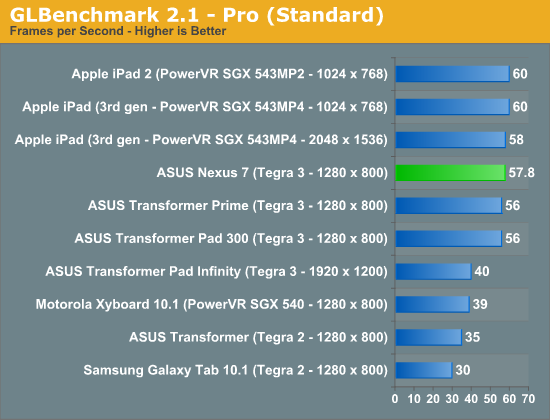
The Transformer Pad 300 uses the same T30L SoC as the Nexus 7, so it isn't surprising to see the two post numbers very close to each other in so many places.
I should note on the browser synthetics that we're also talking about Chrome here, not "Browser" as the Nexus 7 is the first Android device to ship with Chrome as the default browser. In this case, that means there's no "browser" to be found anywhere on the device. You can still install Flash from the Play Store, it just doesn't do anything anymore.
Speaking of digging, I sent Francois Simond (@supercurio) a voodoo report from the Nexus 7, and he has graciously done a component analysis just like we've done with other devices in the past. There aren't too many surprises inside. WiFi and Bluetooth is courtesy the ever-ubiquitous BCM4330 module, which no doubt has gotten cheaper now that BCM4334 is out. The front facing camera is a Aptina MI 1040 1.3MP CMOS with 3.6µm pixels and 1/3" optical format. NFC comes courtesy a new NXP PN65 controller which is best I can tell a PN544 with embedded SE (secure element).
The next question is what that display looks like. We've seen other lower cost tablets ship before, but usually the first thing that gets skimped on is the display. In the case of the Nexus 7, ASUS notes that the panel is an LED backlit IPS panel with 10 point multitouch and 400 nits maximum brightness. Resolution is of course WXGA (1280 x 800) at 7". If you do the math out, that's a pretty high PPI, and in person it looks great - I can't see pixels unless I look very closely.
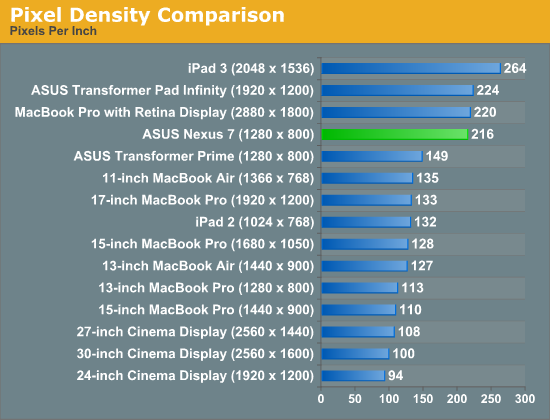
Since I expected having to do something of a tablet review on this trip to Google I/O, I brought along my i1D2 colorimeter. I took measurements on the Nexus 7 using my normal workflow – a combination of Francois' Voodoo Screen Test Patterns and Color HCFR.
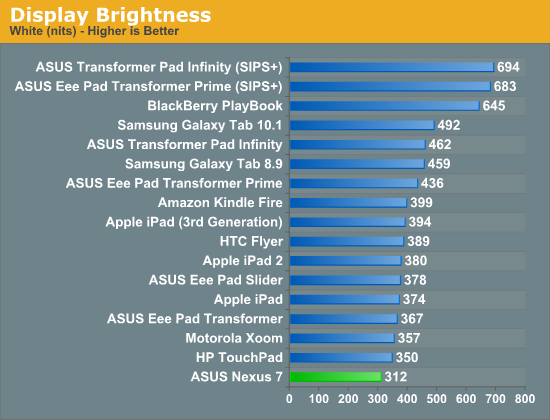
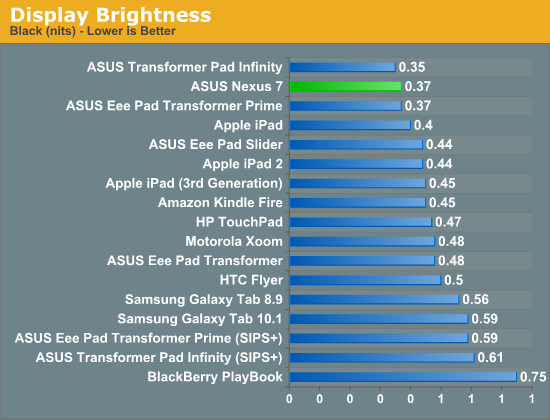

Brightness falls a bit short of the advertised 400 nits at just 312 nits. I'm actually not sure whether there's some of Nvidia's Prism power saving tech going on here (there's no toggle anywhere for it), but that's as bright as I could get the Nexus 7 to go. Contrast on the other hand is pretty good, at 850, and blacks are very good at 0.37 nits.
The rest of the display metrics are a bit interesting, with color temperature hovering around 5500K which is a bit warm for my taste, and gamma isn't flat over the grey scale either. What's really curious to me is that the greens seem undersaturated (the larger triangle is sRGB), which was my first impression on seeing the Nexus 7 while installing some apps from Google Play (which has lots of green). Again I'm not sure whether this is some power saving Prism technique at work here.
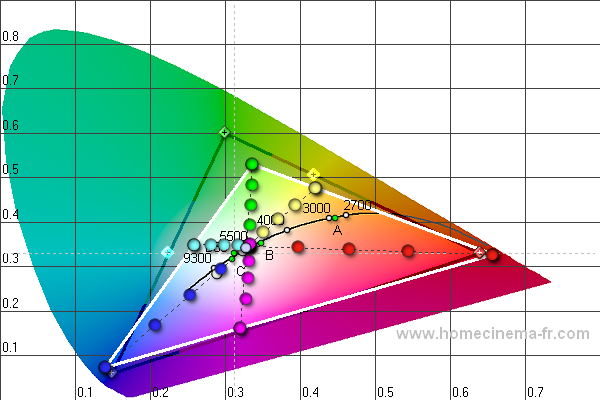
I feel like those metrics could mislead you into thinking the display is bad, on the contrary it's obvious this is an IPS panel based on the viewing angles, which are superb off axis in the horizontal and vertical. You just can't get away with putting a TN in a tablet because of how bad viewing angles are immediately visible on a big surface device like a tablet. The Nexus 7's IPS display is very contrasty and has a high enough PPI that I'm not wishing for higher resolution.
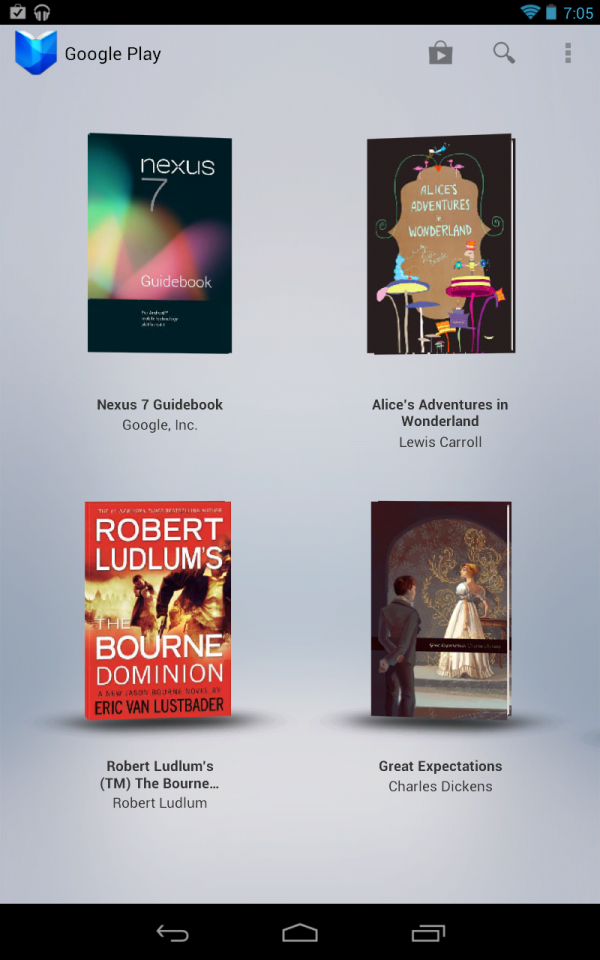
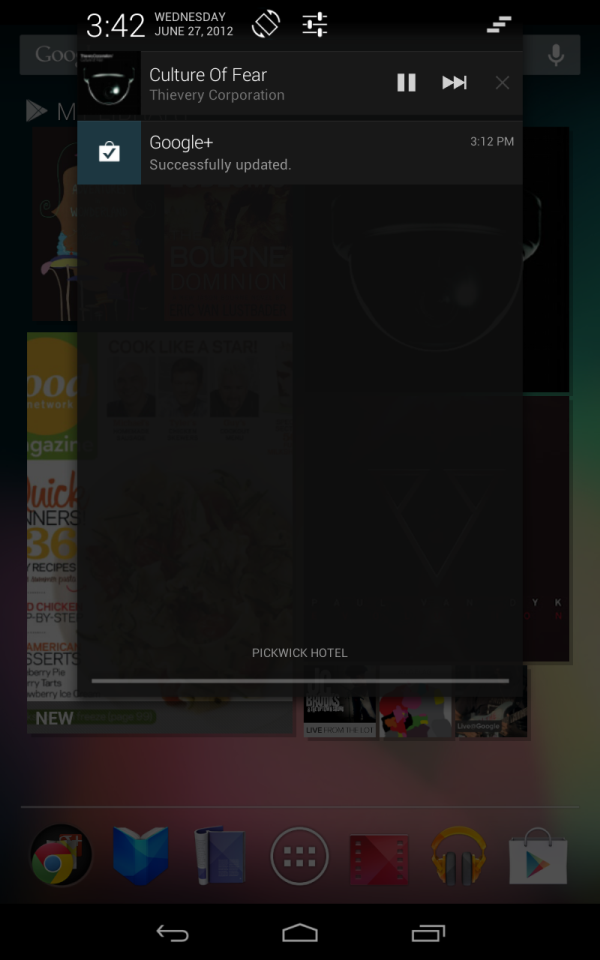
Left - some bundled Google Play books, Right: Notice the new rotation lock toggle on the notification shade, and new style
Google is also doing something interesting with the Nexus 7 by bundling a $25 Play Store credit which pops up in your account after signing into your Google account for the first time. The strategy seems pretty obvious here - get Nexus 7 buyers to at least check out the Play stores. In addition, they've preloaded a number of books and videos which should bait users into at least checking out the respective Google Play applications.
Honestly I think ASUS and Google have really done an excellent job here with the Nexus 7. The combination of a quad core SoC, IPS panel, solid construction, and the latest version of Android all for such a killer price point pretty much make it hard to really find any faults. Sure, it'd be useful to have a full size USB host port, microSD slot (though no Nexus has shipped with one since Nexus S), 5 GHz WiFi (Nexus 7 is 2.4 GHz only), or cellular, but the tablet wouldn't be $199 anymore. I also really feel like the 7 inch diagonal form factor is an ideal one, and the Nexus 7 is quickly growing on me.
Update: I've had many emails and questions about whether USB-OTG (On The Go) is supported on the Nexus 7, and didn't touch on it when I originally hit publish becuause I wasn't entirely sure. I've now confirmed that USB-OTG is supported on the Nexus 7, and works on the current Android 4.1 non-final build that has been sampled. That's encouraging, and I'll test it myself when I get home and to my miniUSB OTG adapter.
Update 2: I've asked for further clarification about what USB-OTG functionality is supported. Using a mouse and keyboard will be supported, and I saw Google using an ethernet to USB adapter over USB-OTG as well. Unfortunately I found out that mounting USB storage will not be supported natively. In addition MHL is not supported.
Now, what about Android 4.1?


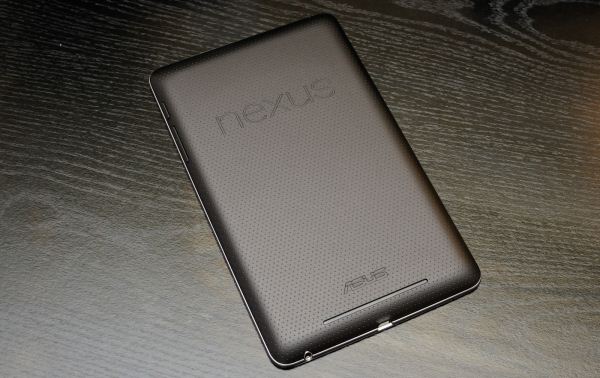







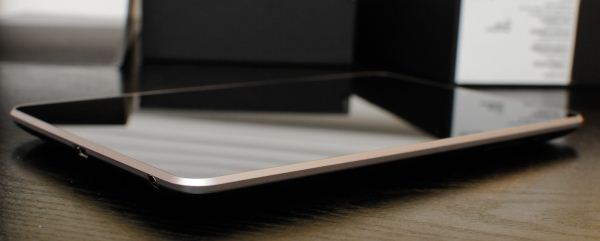
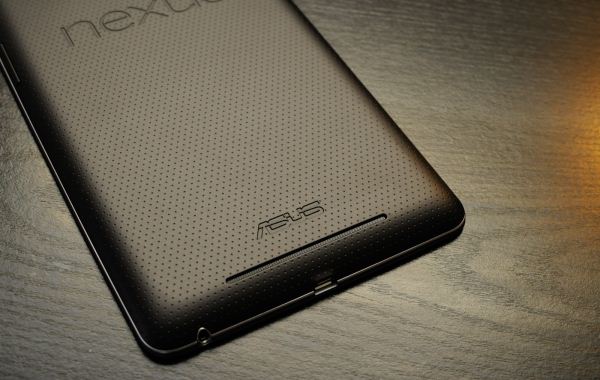






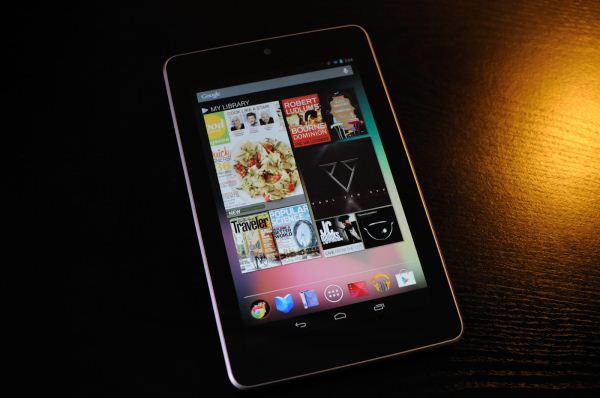








188 Comments
View All Comments
zelachang - Thursday, June 28, 2012 - link
Honestly, who takes pictures of stuff with their tablet? You don't need 3 devices for taking mediocre pictures, which is what any tablet/phone camera is going to do. Front facing at least makes sense for video chatting.steven75 - Thursday, June 28, 2012 - link
Rear facing is also helpful for showing people things in video chat.JasonInofuentes - Sunday, July 1, 2012 - link
Yes, but that's a bit of an edge case. And since video chat isn't even the most common thing in the world, it's edge case on top of fringe case.JasonInofuentes - Sunday, July 1, 2012 - link
+1trip1ex - Monday, July 2, 2012 - link
Well taking pictures is one thing a 7" tablet could be better at than the iPad.gatorproof - Thursday, July 5, 2012 - link
Confusing statement. Possibly the best tablet is the one on the new Asus TF700T, it has an extra lens and other camera improvements. If I understood you correctly, it sounded like your theory was 7" would take better pics then a larger tablet. I think the science is in the camera features and so on, not the size.tipoo - Thursday, June 28, 2012 - link
Front facing is for video chat, a nice feature on tablets. With something this cost constrained though a rear facing camera would have dubious value, think about who the customers are, they probably have smartphones and dedicated cameras already, few serious shots would be taken with a tablet rear camera.uhuznaa - Friday, June 29, 2012 - link
Especially for video chat a rear camera can be very useful (to show things to someone while still being able to see what you're aiming at). Same for taking shots of documents, or scanning QR tags...On the other hand -- OEMs now can offer tablets with a SD slot, a rear camera and a kickstand and still sell them for $300.
Arbie - Thursday, June 28, 2012 - link
Or at least probably so. I would get a tablet like this (no cellular) to play media portably. SD is the cleanest way I've found to supply that. A micro-SD slot is so small and cheap technically that it should have been there. I'm very sorry it isn't.
tipoo - Thursday, June 28, 2012 - link
Everyone is complaining over the lack of expandable storage, but it's still 200-250 bucks for a tablet with a really fast SoC, at the forefront of OS updates, nice screen, etc. It's more powerful than the Kindle Fire and less locked down. I like it, after some reviews and my own hands on I'll seriously consider getting one. Most content I see is on the web anyways, and 16GB is enough to hold over on a long flight, I can forgive the lack of an SD card for everything else.